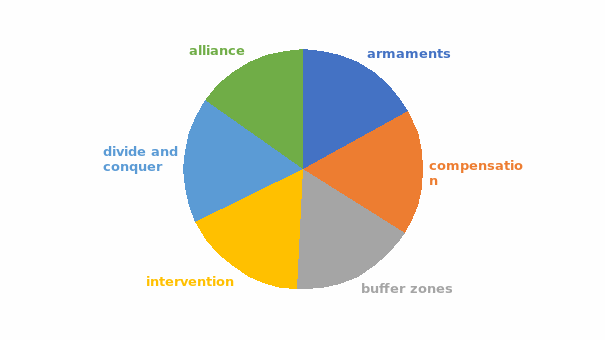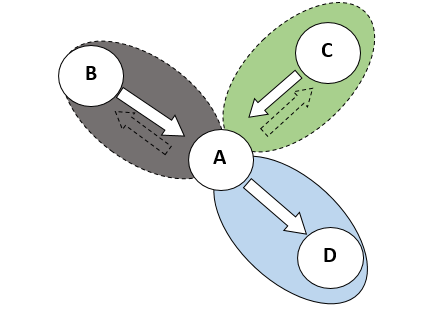The modern world is characterized by a great deal of instability that can threaten the world order established after the Second World War. It becomes clear that the created paradigms are inefficient in meeting the challenges of the world that ceased to be two-pole over two decades ago. The issues concerning alliances come to the fore as countries are trying to ensure stability and the balance of power. This paper includes a generic hypothesis related to the existing world order through the lens of the theory of power balance.
The balance of power theory is one of the most widespread approaches to treating issues related to international relations as well as processes taking place within nations. The balance of power theory holds that countries are “constantly engaged in building, maintaining, and defending the international balance,” which is the balance of power central to stability and peace in the world. The major premise of the theory is that countries try to gain resources and build alliances to make sure that no other nation can swallow them.
Since all countries are involved in such processes, the international balance is achieved as countries balance each other. At that, such variables as alliance formation and level of threat are central to understanding the peculiarities of modern international relations. It is necessary to identify major concepts of the Power Balance theory to apply it effectively and develop a hypothesis involving the variables mentioned.
As has been mentioned above, the theory is grounded on the assumption that all countries strive for gaining power. Some of them try to achieve the preponderance of power while others focus on being safe and avoiding situations when they can be swallowed by more powerful nations. Two primary patterns of the balance of power have been identified, direct opposition and competition. The pattern of direct opposition implies the situation when one nation wants to take control over the other that “refuses to yield.” The pattern of the competition involves three actors. Two bigger nations’ powers are quite equal, and they balance each other, which makes it impossible for them to gain control over the third country.
Apart from the basic principles governing international relations, it is important to understand instrumentation used by countries. Researchers have outlined several tools countries use to achieve their goals in terms of gaining or maintaining power. These instruments include armaments, compensation, buffer zones, alliances, intervention, and divide and conquer. Armament is one of the easiest ways to gain and exercise power over other nations as the country that has a mighty army and sufficient weapons (nuclear weapons, for example) may control to a certain extent other countries.
The next tool, seizing territories, involves the situation when a more powerful country (country A) is about to swallow a less powerful nation (country B) but has to share with other powerful actors (country C). Thus, country A has to give away a part of the seized territories of country B to compensate for the disturbance of the balance of power created previously. The establishment of alliances implies the collaboration of nations that want to gain or maintain their powers.
Setting up buffer zones consists of ensuring the neutrality of a weaker nation located between two powerful countries. Intervention is a common practice in international relations since many powerful countries interfere with the internal affairs of smaller and less powerful nations. The final tool to be described is divide and conquer which implies activities of a powerful country aimed at breaking alliance (or encouraging, at least, some actors to withdraw) that prevent the nation from achieving its goals. It is important to keep these instruments in mind when considering the variables mentioned above.
The level of threat is the independent variable that can be applicable when focusing on international relations. The level of threat involves possible risks a country may face in the international arena as well as regarding domestic issues. When applied within the context of the Power Balance theory, the level of threat can be regarded as a measurement of possible tools that can be used against a country (see figure 1). Importantly, the degree of power of the alliance (both existing or possible) is also associated with a threat as weak alliances make nations vulnerable to other risks.

The distribution of elements is different for every country as each nation can be a target of each of these threats. Importantly, the size of the country, resources available as well as the amount of power gained affect the level of threat. It is necessary to note that even large and powerful countries are often under pressure, and the level of threat can be even higher compared to smaller nations. For instance, in small countries, the level of threat can be quite low if they have formed strong alliances with other small or bigger nations. At that, the level of threat of powerful countries can grow due to the empowerment of other actors (including alliances of smaller countries). Therefore, when looking into international relations, the use of this independent variable is critical.
The dependent variable that can be employed to evaluate the peculiarities of international relations is alliance formation. This involves such aspects as the willingness of actors to participate and the size of contribution aimed at the increase of the alliance power. As has been mentioned above, the alliance is seen as an effective tool to address challenges including a high level of threat. Remarkably, the size and power of a nation are not relevant when measuring alliance formation.
It is possible to come up with a generic hypothesis concerning international relations. Thus, the level of threat the country faces positively correlates with the alliance formation that can be measured by the affected country’s willingness to form an alliance and keep it strong and viable. The contribution of the country to the development of the alliance is also important. The generic hypothesis can be formulated as follows: Country A if facing a high level of threat from countries B and C is willing to ally with county D, or even B or C (see figure 2).

In conclusion, it is possible to note that the theory of power balance allows us to identify and evaluate certain processes that take place in international relations. It is clear that countries face various threats, and the level of threat affects the way the nation develops international relations. Countries are striving for gaining power or remaining independent, which is often achieved through alliance formation. The level of threat affects the way nations collaborate within alliances as well.
Bibliography
Fritz, Paul, and Kevin Sweeney. “The (de)Limitations of Balance of Power Theory.” International Interactions: Empirical and Theoretical Research in International Relations 30, no. 4 (2004): 285-308.
Morgenthau, Hans J. Politics Among Nations: The Struggle for Power and Peace. New York: McGraw-Hill, Inc., 1993.
Organski, A.F.K. World Politics. New York: Alfred A. Knopf, 1964.
Waltz, Kenneth N. “Structural Realism After the Cold War.” International Security 25, no. 1 (2000): 5-41.